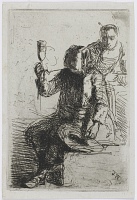The Dutchman Holding A Glass | ||
| Number: | 4 | |
| Date: | 1857 | |
| Medium: | etching | |
| Size: | 82 x 56 mm | |
| Signed: | 'J. W.' at lower right | |
| Inscribed: | no | |
| Set/Publication: | no | |
| No. of States: | 2 | |
| Known impressions: | 4 | |
| Catalogues: | K.4; M.3; T.- | |
| Impressions taken from this plate (4) | ||
KEYWORD
drink, figure, glass, man, woman standing.
TITLE
There are minor variations in title, but none apparently coming from Whistler:
'... a man (Dutch) holding up a large glass in his right hand ...' (1874, Ralph Thomas, Jr (1840-1876)). 3
'The Dutchman holding the Glass' (1886, Frederick Wedmore (1844-1921)). 4
'Dutchman holding Glass' (1890/1892, Beatrice Whistler (1857-1896)). 5
'Dutchman holding a glass' (1900, Caxton Club). 6
'Man holding a glass' (1909, Howard Mansfield (1849-1938)). 7
'The Dutchman holding a Glass' (1910, Edward Guthrie Kennedy (1849-1932)). 8
Thomas was the first to describe the subject as 'Dutch', and Wedmore followed suit. Whistler's wife based her list of etchings partly on Wedmore's catalogue, and although there is no absolute certainty that Whistler himself authorised this title, it would appear that he did not dispute it. Later, Mansfield lent an impression to the Caxton Club as 'Dutchman holding a glass' (), but in his 1909 catalogue he apparently decided that it was not necessarily a Dutch scene, and called it 'Man holding a glass'. Kennedy had no such doubts and called it 'The Dutchman holding a Glass', which has been generally accepted.
'... a man (Dutch) holding up a large glass in his right hand ...' (1874, Ralph Thomas, Jr (1840-1876)). 3
'The Dutchman holding the Glass' (1886, Frederick Wedmore (1844-1921)). 4
'Dutchman holding Glass' (1890/1892, Beatrice Whistler (1857-1896)). 5
'Dutchman holding a glass' (1900, Caxton Club). 6
'Man holding a glass' (1909, Howard Mansfield (1849-1938)). 7
'The Dutchman holding a Glass' (1910, Edward Guthrie Kennedy (1849-1932)). 8
Thomas was the first to describe the subject as 'Dutch', and Wedmore followed suit. Whistler's wife based her list of etchings partly on Wedmore's catalogue, and although there is no absolute certainty that Whistler himself authorised this title, it would appear that he did not dispute it. Later, Mansfield lent an impression to the Caxton Club as 'Dutchman holding a glass' (), but in his 1909 catalogue he apparently decided that it was not necessarily a Dutch scene, and called it 'Man holding a glass'. Kennedy had no such doubts and called it 'The Dutchman holding a Glass', which has been generally accepted.
3: Thomas 1874[more] (cat. no. 81).
4: Wedmore 1886 A[more] (cat. no. 3).
5: List, GUW #12715.
6: Chicago 1900 (cat. no. 3).
7: Mansfield 1909[more] (cat. no. 3).
8: Kennedy 1910[more] (cat. no. 4).
DESCRIPTION
On the right, a woman in a low-necked dress, her hair scraped back (under a scarf or close bonnet), is putting a bowl on a table. In front, and facing forwards and to the left, a man sits smoking a long-stemmed pipe. In his right hand he holds a tall slender glass by its stem. He has lank, shoulder-length hair and a big moustache. He wears a jacket with a broad sash over loose trousers gathered into wide-topped boots. His broad-brimmed hat is upside down on the bench on which he sits. The scene is lit strongly from the right, casting shadows behind and to the left of the figures.
DISCUSSION
Thomas described the man as 'Dutch' and holding a 'large wide-awake at his left hand' (a wide-awake is a hat with a low crown and wide brim, resembling those worn by the Quakers in the USA, which was popular in the early 19th century). 9 However, the hat actually suggests an earlier date, and is typical of Dutch 17th century costume.The figures and accessories (the pipe and glass) suggest that it is based on 16-17th century Dutch art, and it may be a copy of a painting or a print.
9: Thomas 1874[more] (cat. no. 81).
Lochnan compares the composition, with 'its use of period costume and overt references to a school of the past', to the etching Rembrandt and his wife Saskia (B. 19, 1636) by Rembrandt Harmens van Rijn (1617-1681). 10
10: Lochnan 1984[more], pp. 24-25.
